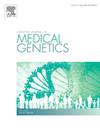涉及SLC6A1的3p缺失综合征的癫痫发作和脑电图表现
IF 1.7
4区 医学
Q3 GENETICS & HEREDITY
引用次数: 0
摘要
3p缺失综合征是一种罕见的遗传性疾病,其特征是智力障碍、生长迟缓、低张力和独特的面部特征,具有相当大的表型变异性。先前的报告强调了3p25.3区域缺失的重要性,这有助于天使样特征的发展,如刻板的动作、快乐的举止、癫痫和特征性脑电图(EEG)模式。本研究对22例3p缺失综合征患者进行分析,重点分析癫痫和脑电图的表现。在3p25.3中有一个新定义的短最小重叠区(sSRO),约52 kb,部分包括SLC6A1和SLC6A11,与angelman样特征有关,特别是癫痫和脑电图模式。sSRO缺失患者癫痫发作发生率高(60%),以肌阵挛或癫痫缺失为特征,脑电图显示广泛性高振幅慢波。相比之下,超过sSRO的较大缺失与3p综合征的畸形特征、全身性强直阵挛性发作和非特异性脑电图结果有关。这些发现表明,SLC6A1功能障碍可能通过GABA转运受损导致癫痫和脑电图异常,而较大缺失或非重叠缺失的患者表现出更典型的3p综合征特征,这表明更广泛缺失区域的多个神经系统基因可能独立地导致更严重的神经系统表型。总之,在观察与Angelman综合征相似的特征性癫痫和脑电图结果时,考虑gaba相关疾病是很重要的,包括一种特殊的染色体异常,即在SRO区域有微缺失的3p综合征。本文章由计算机程序翻译,如有差异,请以英文原文为准。
Epileptic seizures and EEG findings in 3p deletion syndrome involving SLC6A1
3p Deletion syndrome is a rare genetic disorder characterized by intellectual disability, growth delay, hypotonia, and distinctive facial features, with considerable phenotypic variability. Previous reports have highlighted the significance of deletions within the 3p25.3 region contributing to the development of Angelman-like features, such as stereotypic movements, a happy demeanor, epilepsy, and characteristic electroencephalogram (EEG) patterns. This study analyzed 22 patients of 3p deletion syndrome, focusing on epilepsy and EEG findings. A newly defined short smallest region of overlap (sSRO) within 3p25.3, encompassing approximately 52 kb and partially including SLC6A1 and SLC6A11, was associated with Angelman-like features, particularly epilepsy and EEG patterns. Patients with sSRO deletions exhibited a high incidence of seizures (60 %), characterized by myoclonic or absence seizures, with EEG showing generalized high-amplitude slow waves. In contrast, larger deletions beyond the sSRO were linked to dysmorphological features of 3p-syndrome, generalized tonic-clonic seizure, and non-specific EEG findings. These findings suggest that SLC6A1 dysfunction contributes to epilepsy and EEG abnormalities, possibly via impaired GABA transport, whereas patients with larger or non-overlapping deletions exhibited more typical 3p-syndrome features, suggesting that multiple neurological genes in the broader deletion region may independently contribute to more severe neurological phenotypes. In conclusion, it is important to consider GABA-related disorders, including a specific chromosomal abnormality known as 3p-syndrome with a microdeletion in the SRO region, when observing characteristic epilepsy and EEG findings resembling Angelman syndrome.
求助全文
通过发布文献求助,成功后即可免费获取论文全文。
去求助
来源期刊
CiteScore
4.10
自引率
0.00%
发文量
193
审稿时长
66 days
期刊介绍:
The European Journal of Medical Genetics (EJMG) is a peer-reviewed journal that publishes articles in English on various aspects of human and medical genetics and of the genetics of experimental models.
Original clinical and experimental research articles, short clinical reports, review articles and letters to the editor are welcome on topics such as :
• Dysmorphology and syndrome delineation
• Molecular genetics and molecular cytogenetics of inherited disorders
• Clinical applications of genomics and nextgen sequencing technologies
• Syndromal cancer genetics
• Behavioral genetics
• Community genetics
• Fetal pathology and prenatal diagnosis
• Genetic counseling.

 求助内容:
求助内容: 应助结果提醒方式:
应助结果提醒方式:


